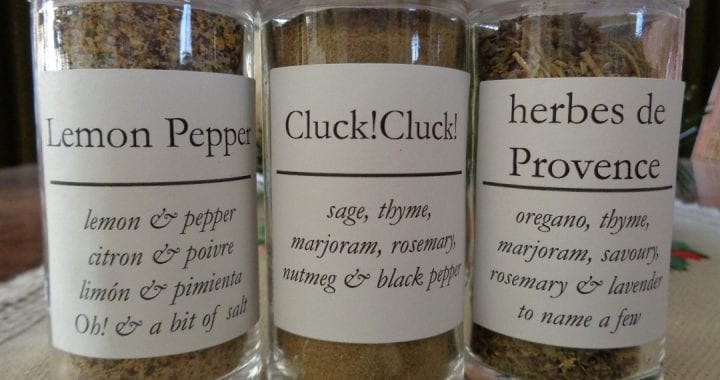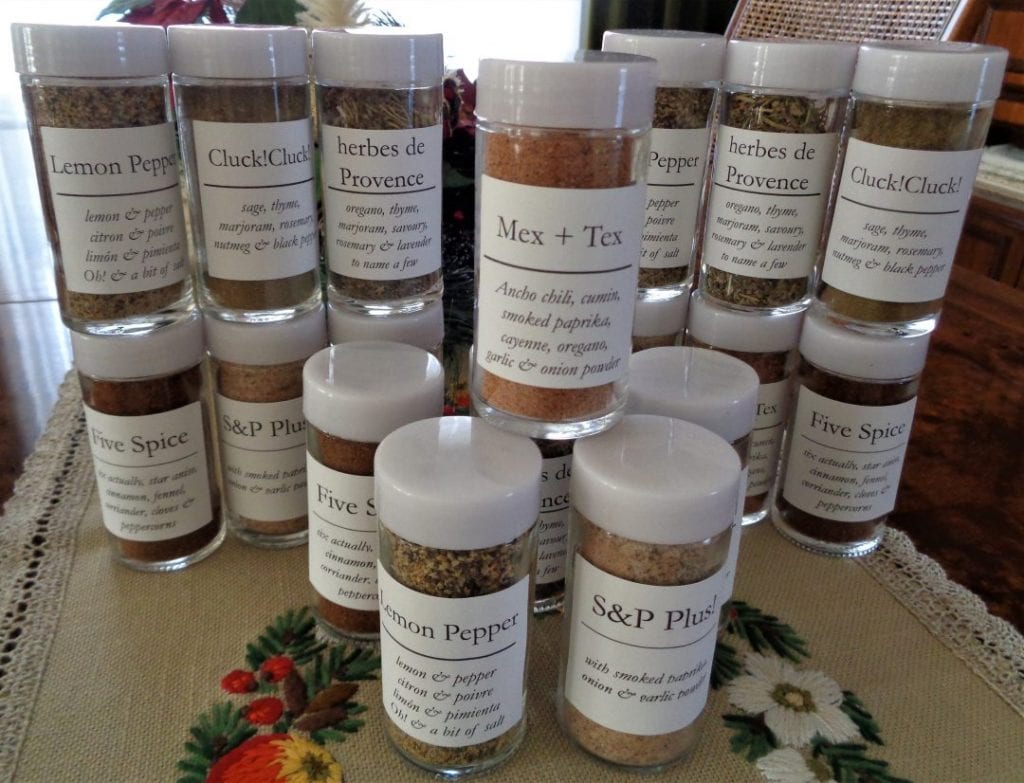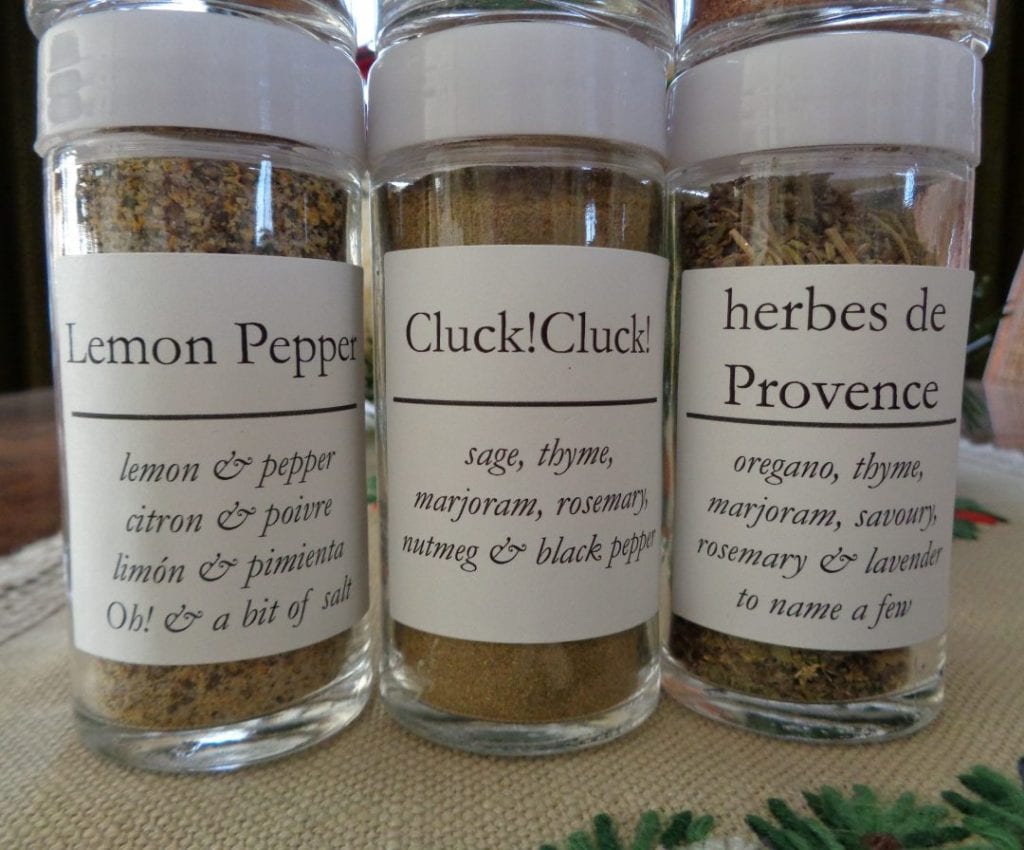As the season of presents draws ever closer, so the to do list grows more intense. Running around the shopping malls holds no appeal to me so I usually turn to things I can create at home. The bonus I have in my life is that many of my friends and associates are very happy with things that go away; candles, lotions, food and other things that don’t require washing, dusting or long term space.
This year I decided to blend spices and learned a few things along the way.
1. The packaging can cost more than the contents if “someone” is not paying attention.
2. Dry roasting and grinding is all well, good and fun but sometimes buying the ground powder is a better option. If there is not a good grinder easily accessible, definitely start with powder.
3. Keeping a mask or hankerchief handy is an excellent idea requirement.
4. What is saved in $$’s may be lost in time so consider your choices, especially at this time of the year.
5. Local ethnic grocers can be a budget wise option.
So let’s get started with three mixes and I will finish up tomorrow with three more that became my six packs of gift giving. There is absolutely no need to do six, it was just what worked out best in my set of circumstances. I had decided to do 12 sets as that matched the Avery labels I was planning on using, so 72 bottles in total and 4 1/2 cups of each blend.
Lemon Pepper
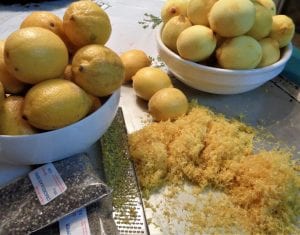 First off lemons are not really in season here right now so they were pricey and it took a little looking. I did eventually find 4 bags of 12 organic lemons on sale as they were in need of being used up. Perfect for what I needed and at half the cost of the .80 each I was seeing everywhere else.
First off lemons are not really in season here right now so they were pricey and it took a little looking. I did eventually find 4 bags of 12 organic lemons on sale as they were in need of being used up. Perfect for what I needed and at half the cost of the .80 each I was seeing everywhere else.
An additional consideration is what to do with all the lemon juice. I bottled and froze most of the juice for later use (cold season) and turned some into lemon curd.
Begin by removing any labels and then washing and drying the lemons. Grate and mix with cracked black pepper. Turn onto a 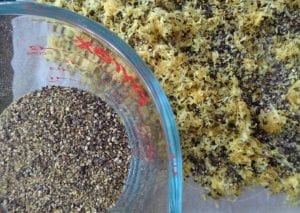 parchment lined baking try. Spread to fill the space. Dry at the lowest temperature your oven will register until the zest is fully dry. Stir and spread out again several times in the process.
parchment lined baking try. Spread to fill the space. Dry at the lowest temperature your oven will register until the zest is fully dry. Stir and spread out again several times in the process.
Once dry, pulverize in a grinder, mix in the salt and transfer to a container. Label.
The cracked pepper will reduce in size in the grinder but another option is to dry just the lemon zest and then add finely ground pepper and salt after the zest has been ground. I started with 48 lemons so here are the quantities for a smaller batch.
4 – 5 fresh lemons
1/3 cup cracked black pepper
1/4 cup fine sea salt
Cluck! Cluck!
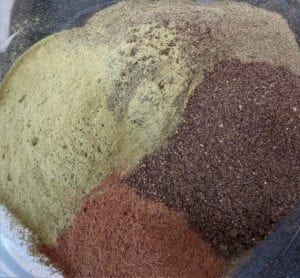 That was my name for poultry seasoning. It is quick & easy as it can be made with no roasting or grinding involved. It is simply a matter of mixing powders. If ground powders are not available or, better yet, if the ingredients are from your garden and are in dried leaf form, grind individually before combining to get the proper proportions. Once mixed bottle, label and store away from moisture, heat and light.
That was my name for poultry seasoning. It is quick & easy as it can be made with no roasting or grinding involved. It is simply a matter of mixing powders. If ground powders are not available or, better yet, if the ingredients are from your garden and are in dried leaf form, grind individually before combining to get the proper proportions. Once mixed bottle, label and store away from moisture, heat and light.
2 Tbsp. sage
1 1/2 Tbsp. thyme
1 Tbsp. marjoram
3/4 Tbsp. rosemary
1 1/2 tsp. nutmeg
1 1/2 tsp. black pepper
herbes de Provence
The nice thing about herbes de Provence is that it is flexible. The frustrating thing about herbes de Provence is that it is flexible. Oregano, thyme, marjoram, savoury, rosemary & lavender are popular and basil, fennel, parsley, tarragon, bay, chervil and mint have also been known to find their way into the blend. Think of it as being a little like different vintages of wine. One years finished product, may not taste exactly like anothers and that is okay. Tweak the mix until it works for you. I left this blend in larger pieces as it is very often used in recipes that require moisture and a lengthy cooking time.
4 Tbsp. thyme
3 Tbsp. marjoram
3 Tbsp. savoury
2 Tbsp. rosemary
1 Tbsp. tarragon
1 Tbsp. oregano
1 tsp. chervil
1 tsp. lavender
Toss the pieces together until will mixed and bottle. Label and store in a dark cool location. There is a tendency for the herbs to settle over time as seen inthe the bottle below.
Labeling
Many stores will no longer print on labels as they can stick in the machine. That means printing at home which will require, a printer, enough toner, a package of labels and patience. Do not expect them to print correctly the first time. Bonus if it does, just don’t expect it. The change in thickness of the paper going through the feeder can create issues. It may look all perfect on your computer screen and when a sample page is printed on regular paper but things can happen when the labels are used.
I opted for what was already at home. They were matte and if I were starting from scratch for a project like this again I would go for glossy labels as they will stand up better in a kitchen environment. I chose simple black & white labels for two reasons. I didn’t want to use up all my colour toner and all the spices blends were going to create different colour background so black would work with all of them.
One of the reasons I have highlighted budget here is that experience has taught many DIYers that there are some things that make sense to do yourself and other times the cost of gathering all the parts of the project can make you think twice and refine plans. Purchasing bottles, washing and drying them, choosing paper, creating the designs, buying toner, two trips to other friends with printers and the hours involved to achieve properly printed labels for each bottle took time and had little to do with blending spices. Caligraphy would be a less intricate option if that is in your skill set. All of which is in no way insurmountable. It is just that being aware of possible hiccups before starting is helpful. The pouches included in a parcel going to Japan with hand written tags were a breeze in comparison.
Like kneading bread and cutting cookies, blending spices is a hands on experience. Become a part of the process. Stir and mix with intention. Toss with love and bottle with gratitude for the friends you will be sharing your little treasures with.
Blending Herbs ( Part One ) from My Kitchen Wand

